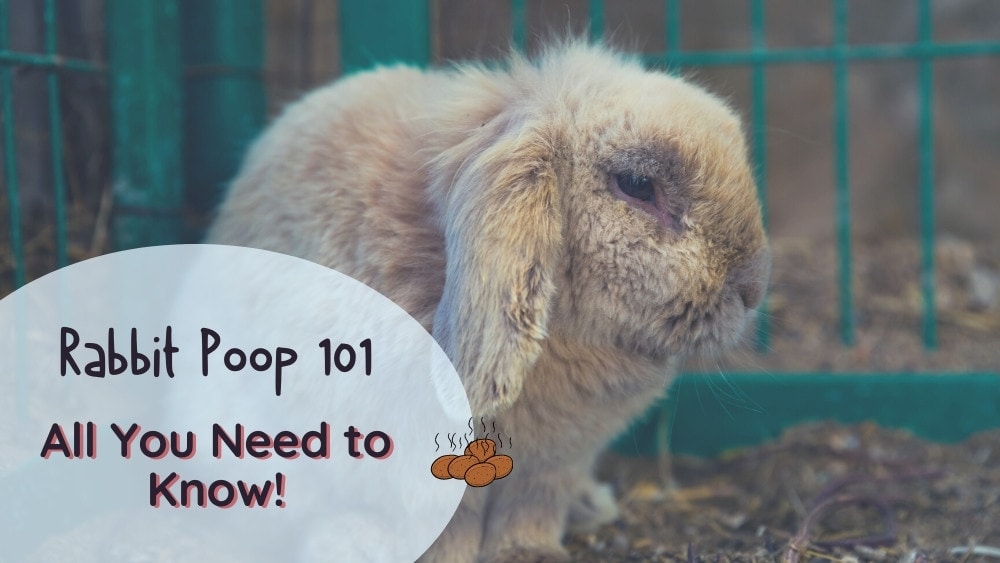Cleaning out the rabbit’s hutch may seem like one of the more mundane tasks of rabbit ownership. But did you know that bunny poop can tell you a lot about rabbits’ health – and could even help you save your pet rabbit’s life?
You may think that sounds overdramatic, but after ten years looking after rabbits in veterinary practices, I can tell you that it’s true. Our pet rabbits evolved as prey species, where showing weakness or illness was a death sentence – and as a result, they don’t give us many clues when they’re sick.
Their poop, on the other hand, has a lot to say. Sometimes, it gives us enough of a heads’ up to get treatment on board in time to save a life.
This article is a deep-dive into the topic of rabbit poop: what’s normal, what’s not, and what it’s telling you about your pet’s health. So buckle up, as we go through all you need to know about rabbit poop.
What Do I Need to Know About Rabbit Poop?
As a rabbit owner, you need to know about the types of rabbit poops, and what is normal and abnormal. Your rabbit’s poop can tell you a lot about your rabbit’s health, long before you notice they are sick. You also need to know what to do if your rabbit’s poop isn’t normal.
1. There Are Two Types of Rabbit Poop
Rabbits produce two types of poop: fecal pellets and cecotropes. From a rabbit owner’s observation, fecal pellets form the bulk of a rabbit’s poop, while cecotropes are rarely or never seen.
These two types of poop are a result of the rabbit’s a unique digestive system that allows them to extract as many nutrients as possible from their food.
Fecal pellets
Fecal pellets are the small, brown, firm poops that you’re probably familiar with. They’re mostly made up of fiber and waste products from the body.
Ingested food enters the stomach, where it is sterilized and broken down into smaller particles in a very acidic environment. The material progresses to the small intestine, where a few nutrients are extracted.
Indigestible fiber is squeezed dry and passed out through the rectum as pellets. The pellets are released during the day as the rabbit consistently nibbles on its food.
A rabbit’s digestive tract requires plenty of fiber to maintain its motility, and a rabbit’s diet provides this in the form of high-fiber grasses and hays.
Unlike cows and horses, who are large enough to store fibrous material in their digestive tracts for a long period, rabbits are small, and they handle fiber by eliminating it quickly – hence the large number of poops!
Cecotropes
While the indigestible fiber is excreted as fecal pellets, digestible fiber moves on to the cecum, where it undergoes bacterial fermentation to produce proteins, fatty acids, and various vitamins.
The cecum is not very effective at absorbing these nutrients, so they are excreted as cecotropes, which are usually released at night or during the early morning.
Cecotropes are dark brown, small, soft, glossy pellets clustered together like a bunch of grapes. They are squishy and sticky. They are covered with a thin membrane and release a powerful smell once it is broken or a cecotroph is squished.
So how do cecotropes help a rabbit absorb more nutrients? Glad you asked!
2. Rabbits Eat Their Poop
Yes, you read that right. Rabbits are known for their odd behavior of eating their own feces, an activity known as coprophagy.
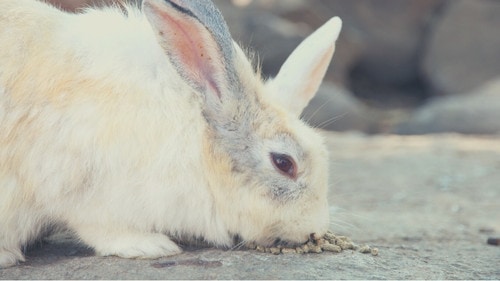
This may seem strange – and a little disgusting – but it is actually a perfectly normal and essential part of a rabbit’s digestion. In fact, failure to eat cecotropes can cause malnutrition.
The nutritional benefit of cecotropes
Cecotropes are rich in nutrients and are essential for a rabbit’s health. This special type of soft rabbit poop gained a lot of fatty acids and vitamins while it was being fermented in the cecum.
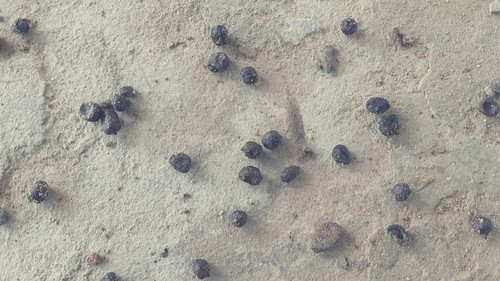
Rabbits can’t produce these nutrients themselves, and their hay-based diet doesn’t provide everything they need, so cecotropes fill in the gap.
Coprophagy in rabbits
The act of eating poop is called coprophagy. Since rabbits eat cecotropes directly from their bottom, you may never see them in your rabbit’s litter box or hutch. And as the process happens at night, you might never catch them in the act.
If you notice your rabbit eating their feces, there is usually no cause for concern.
3. What Does Rabbit Poop Look Like?
Moving on from cecotropes, let’s focus a little closer on rabbit fecal pellets. You might think you know what rabbit poop looks like, but have you ever paid attention to its detailed appearance?
As a rabbit owner, it is essential to be able to tell the difference between normal and abnormal rabbit poop. This will help you figure out whether the diet is right, and whether your rabbit’s digestive system has any issues.
Characteristics of healthy rabbit poop
Normal rabbit poop has certain characteristics:
- Shape: All pellets have a spherical shape and resemble small round balls.
- Size: Rabbit poop should have uniformly sized pellets approximately 6mm in diameter, similar to the size of a green pea or a sweet pea.
- Color: The color of rabbit poops vary depending on their diet. For example, darker poops may indicate too much protein in your rabbit’s diet. Generally, healthy colors range from medium green and dark green, to light brown, dark brown, or almost black. Your rabbit’s poops should have a consistent color throughout.
- Consistency: Normal fecal pellets should be hard to the touch, but not super hard. They crumble easily when you press them between your fingers, revealing a sawdust-like appearance of digested hay.
- Odor: Fecal pellets don’t really smell of poop, although they do carry a light, rabbity smell.
What does abnormal rabbit poop look like?
Abnormal rabbit poop gives you a clue that all is not well. It could indicate the need to adjust your rabbit’s diet or the urgency to seek veterinary help.
- Small misshapen poops: These poops are smaller than usual, and may lack the usual round shape.
- Uneven poops: A mixture of small and large fecal pellets.
- Soft poop: Soft feces, where the pellets are formed but squishy.
- Diarrhea: Diarrhea refers to watery, unformed feces.
- Strung-together poop: Normal fecal pellets that are attached together in a string.
- Double poops: This happens when two or more normal poops merge.
- Mucus in rabbit poop: Rabbit poop mucus appears like a blob of clear jelly covering the poops.
What causes abnormal poops?
There are a lot of factors that can cause abnormal rabbit poop. The most common are:
- Diet: Unhealthy diets containing too many treats or inadequate fiber can cause problems in the gastrointestinal tract. Drastic changes to a rabbit’s diet can also have similar effects.
- Overweight: Overweight and obese rabbits can cause small or deformed poops due to a slow-down of the gut.
- Diseases: Various illnesses, pain, and stress can cause abnormalities in rabbit droppings.
- Parasites: Internal parasites, such as intestinal worms, can cause unusual rabbit poops.
4. How Often Do Rabbits Poop?
A rabbit’s digestive system is adapted to digesting lots of fibrous plant material on a daily basis. Since no food is stored along the way, the digestive tract has to move quickly to get through its workload!
The small intestine contracts every 10-15 minutes, and fibrous rabbit poops are produced almost continuously as a result.
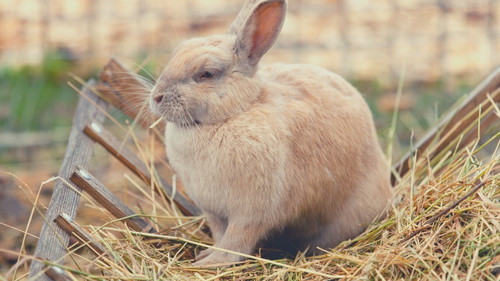
Cecotropes, on the other hand, are released at least 4 hours after feeding, often during periods of rest.
Wild rabbits are prey animals and only release cecotropes in their burrows, safe from their predators. Pet rabbits are also cautious and usually expel cecotropes overnight.
5. How Much Do Rabbits Poop?
Rabbits produce a large amount of feces, sometimes as much as several hundred pellets per day, as well as several bunches of cecotropes which you may never see.
The amount of feces that a rabbit produces can vary depending on a number of factors, including their diet, size, and activity level.
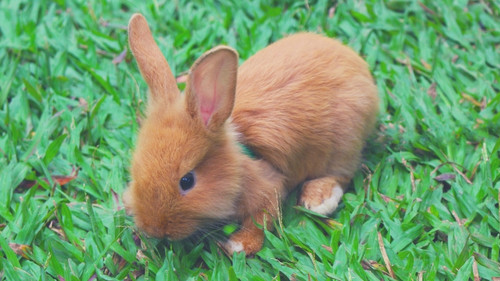
Small rabbits and younger bunnies tend to produce smaller, more frequent feces than larger rabbits. This is because they have a higher metabolism and a faster digestive system, while larger adult rabbits tend to produce larger, less frequent feces because they have a slower metabolism and a slower digestive system.
In general, a healthy rabbit will produce a consistent amount of feces each day, with the majority of the feces being made up of soft, round pellets of a uniform size.
6. Rabbit Poo Can Tell You About Your Rabbit’s Health
Rabbits are prey species, and they often pretend to be fine even when they are ill. Observing bunny poops can give you early warning signs if there’s something going on with their health.
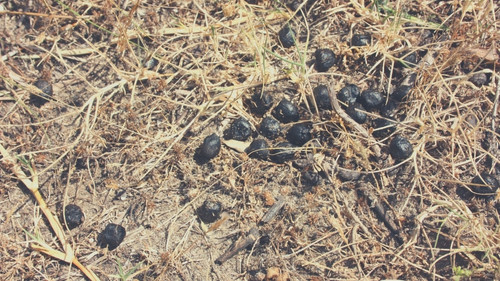
But, as with any secret clue, you need to know how to decode it. Here’s our guide to interpreting changes in your own rabbit’s poop, so you know what might be causing abnormal poop – and what to do about it.
Too big or too small
Changes in your rabbit’s poo size is the most common early flag for a problem.
Rabbit poop may appear too big when two or three pellets have merged. This occasionally happens when your rabbit’s digestive system slows down a little and two pellets coincide.
If you notice this happening for more than a day, you should get your rabbit checked at the vet, in case their digestive system is shutting down.
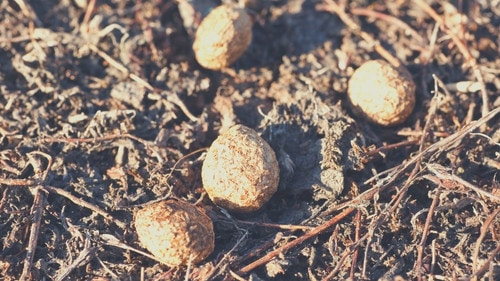
Large poops that are egg-shaped can also be outcomes of megacolon, which means the large intestine is stretched.
Megacolon is a rare genetic occurrence, but can also be caused by trauma. Consult a vet if your rabbit’s poos are continually large like this.
When it comes to a single batch of small poops, stress is the most common culprit. When stressors such as a barking dog or noise result in small poops, they should return to normal after a few hours.
However, if your rabbit produces small poops for more than a day, it can indicate pain, or a partial blockage of the intestine or GI tract, and this warrants a trip to the vet.
Abnormal shape
There are several types of abnormal poop shapes. Here are the most common.
Poos that are strung together and appear in an elongated oval shape can be a common observation in long-haired rabbits.
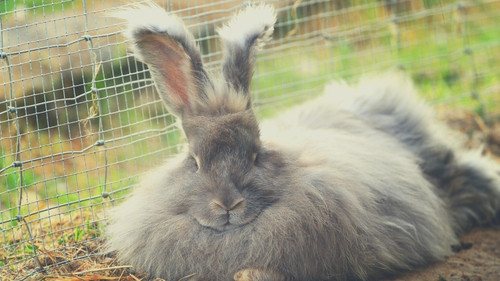
Rabbits do a lot of grooming, and sometimes that molted hair passes into the rabbit poop, stringing it together. You can tackle the issue by brushing your rabbit’s fur regularly.
Deformed poops can be an indicator of dehydration and inadequate fiber intake. You can increase hydration by offering a healthy diet consisting of fresh leafy greens and increasing the amount of fluids.
Boost fiber by giving fresh hay, while reducing treats and feed pellets.
Small misshapen poops can occur when your rabbit isn’t eating enough, meaning the rabbit’s digestive system is slowing down or heading towards GI stasis.
There are several possible underlying causes, such as dental problems, recovering from surgery, or other health issues. Consider small, irregular poops a red flag, and you should seek veterinary help as an emergency.
Too soft
Thanks to the rabbit’s unique digestive system, there are several types of feces that could be classified as soft poop. Here’s the breakdown:
- Cecotropes: A new rabbit owner may see a rabbit’s cecotropes and worry that it’s diarrhea. While cecotropes themselves are normal, it’s not normal to see them, so if you’re regularly seeing cecotropes in your rabbit’s hutch or litter tray, you should get them checked.
- Dietary adjustment: Softer fecal pellets are usually caused by dietary issues. You often see them in young rabbits transitioning from weaning to adult food, and they should clear up after a day or two. If they persist, they might be due to a diet that is too high in carbs, sugar and protein. The first step is to switch to an unlimited hay diet, and reduce carbs, pellets and treats. It can take a few weeks for the cecal flora to return to normal.
- Mucus: Normal rabbit feces should not contain mucus. If you notice mucus in rabbit poop, it could be a sign of a digestive issue. This could be caused by a variety of factors, such as a diet that is low in fiber or an underlying health issue.
- Diarrhea: True diarrhea is a rare condition in rabbits and is an emergency when it occurs. It is characterized by watery poop and can be brought about by parasitic infection, weaning baby rabbits before they’re due, or exposure to poisons. This situation requires urgent medical attention.
7. The Way Your Rabbit Poops Can Give You Extra Clues
It’s not just the rabbit poop itself that helps you gauge your rabbit’s health, but their behavior and pooping pattern can also flag potential problems.
Too frequently
Rabbits are known for producing a large number of fecal pellets on a daily basis, but if you notice that your rabbit is producing an unusually large amount, it could be a sign of a health issue.
Some possible causes of increased fecal pellet production in rabbits include:
- Diet: A diet high in fiber or low in fat can cause rabbits to produce more feces.
- Stress and certain digestive problems: These are interlinked, as stress affects the digestive tract, and can disrupt its natural rhythm.
- Medications: Some medications, such as antibiotics, can also lead to an increase in feces production in rabbits.
If, on the other hand, your rabbit is producing too many cecotropes, here are the main culprits:
- Diet: Diet is the main reason for the overproduction of cecotropes. A rabbit’s digestive tract is efficient in producing a specific amount of cecotropes at the same time daily. But in pet rabbits, consistency depends on the type of food and feeding times. Too much protein, carbohydrates, or sugar can upset the bacterial balance in the cecum, leading to the production of too many cecotropes.
- A sudden change in the diet: Abrupt diet changes can cause an imbalance in a rabbit’s gut, resulting in too many cecotropes.
- Insufficient indigestible fiber: It can interfere with the motility of the digestive system, leading to excess cecotropes.
If you notice that your rabbit is producing an unusually large number of feces, it is important to consult with a veterinarian to determine the cause and determine the best course of action.
Not often enough
Rabbits defecate a lot due to their constant feeding. A reduction in the quantity of your rabbit’s droppings is a red flag for underlying digestive problems that may require immediate vet intervention.
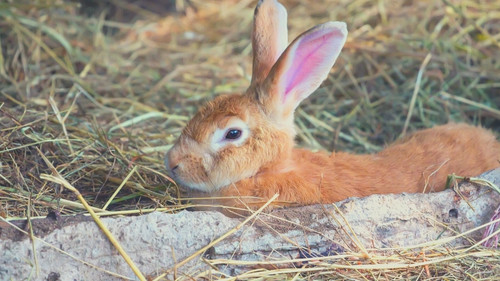
One of the main concerns is that a reduction in fecal production is a symptom of gastrointestinal stasis, or GI stasis. This is a serious health issue that can occur when a rabbit’s intestines slow down or stop functioning properly.
The normal movement of the intestines is essential for maintaining healthy digestion and eliminating waste from the body.
The House Rabbit Society refers to GI stasis as “the silent killer“.
There are several factors that can contribute to gastrointestinal stasis in rabbits:
- Diet: A diet that is low in fiber or high in fat can lead to gastrointestinal stasis in rabbits. This is because fiber is essential for maintaining healthy digestion in rabbits, and a lack of fiber can cause the intestines to slow down or become blocked.
- Dehydration: Dehydration can also contribute to gastrointestinal stasis by causing the feces to become hard and dry, making it difficult for the rabbit to pass them.
- Surgery: This can cause gastrointestinal stasis in rabbits by disrupting the normal functioning of the digestive system. During surgery, the rabbit’s abdomen may be opened, and the intestines may be manipulated. This can cause the intestines to become inflamed or damaged, leading to a slowdown or cessation of normal bowel movements. Additionally, the use of certain medications during surgery, such as painkillers or anesthetics, can also cause changes in the rabbit’s digestive system and contribute to gastrointestinal stasis.
- Obstructions: This condition is caused by a compact mat of hair or other foreign objects swallowed by a rabbit. This condition is an emergency, and no poops will be released during such obstructions.
- Cecal impaction: This is a type of stasis that occurs in the cecum and results in the production of fewer cecotropes due to the imbalance of cecal flora. The condition causes severe illness in rabbits and subsequent GI stasis.
Gastrointestinal stasis is a serious health issue that requires immediate medical attention. Your vet will be able to diagnose the problem and provide the appropriate treatment to help your rabbit recover.
Not keeping clean
Rabbits are generally clean animals and will groom themselves frequently, but there are times when they may not be as clean as they should be. One common issue is a poopy butt, which occurs when feces accumulate around a rabbit’s anus and sticks to their fur.
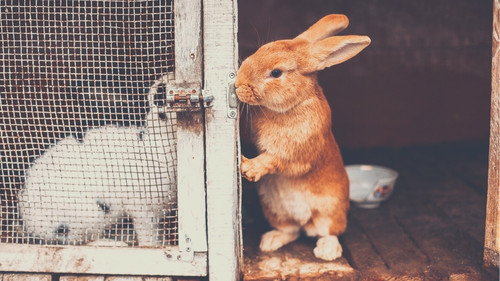
This can happen for a variety of reasons, such as a diet that is low in fiber or dehydration.
A poopy butt can lead to skin irritation and discomfort for the rabbit, and it can also attract flies, which can lead to a condition known as fly strike.
Fly strike is a serious and potentially life-threatening condition that occurs when flies lay eggs on a rabbit’s feces or urine-soaked fur.
The eggs hatch into maggots, which feed on the rabbit’s flesh. Fly strike can be very painful for the rabbit and can lead to serious infection if left untreated.
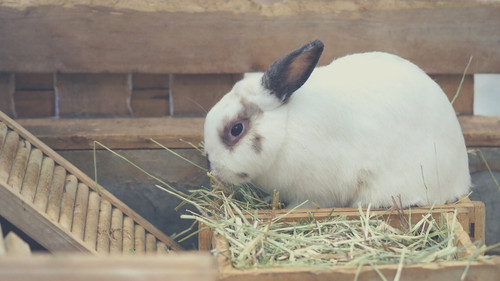
If you notice feces around your rabbit’s bottom, clean it with warm water and make an appointment for a vet to check your rabbit to work out why they’re not keeping clean.
If you notice fly eggs or maggots, go to the clinic immediately as an emergency.
BONUS: Three Things You Probably Didn’t Know About Rabbit Droppings
Rabbit droppings may seem like a simple byproduct of a rabbit’s digestion, but there is actually much more to them than meets the eye. Let’s delve into some things you may not have known about rabbit droppings.
Rabbit droppings usually don’t pose a health risk
Many people may be unaware that rabbit droppings pose no real health risk. Rabbit droppings are generally considered to be safe for humans to handle, provided you wash your hands thoroughly after, as with any animal waste.
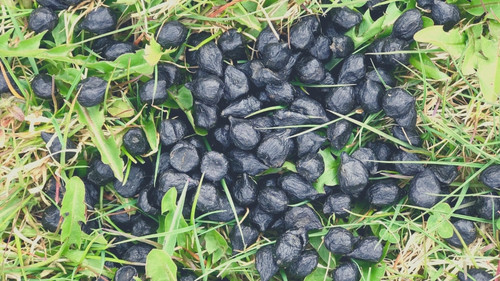
So the next time you see rabbit droppings in your garden or around your home, don’t be afraid to handle them – just be sure to wash your hands afterwards!
You can litter train your rabbit
Tired of cleaning up rabbit poo? Litter training a rabbit is a simple and effective way to manage their waste and keep your home clean.
With a little patience and consistency, it is possible to teach your rabbit to use a litter box, although some rabbits take a bit longer to get used to the process than others.
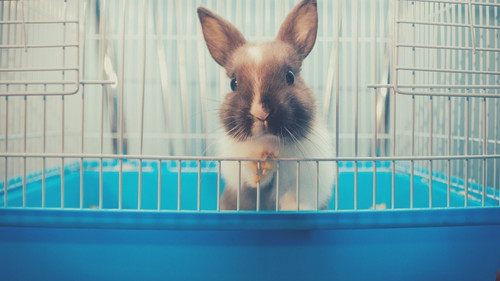
If you’re interested in training your rabbit, you can read our complete guide to rabbit litter training!
You can use rabbit droppings as fertilizer
Rabbit droppings can be a valuable resource for gardeners, as they are a natural and safe fertilizer that can help to enrich the soil and promote healthy plant growth.
Here are some tips for using rabbit droppings as a fertilizer in your garden:
- Collect the droppings: Rabbit droppings can be collected directly from the litter box or from the area where your rabbit spends most of their time. Be sure to wear gloves and wash your hands afterwards.
- Allow the droppings to dry out: It is important to allow the droppings to dry out completely before using them as a fertilizer. This will help to prevent the spread of any bacteria or parasites that may be present in the droppings.
- Add the droppings to the soil: Once the droppings are dry, they can be added directly to the soil around your plants. Alternatively, you can mix the droppings with water to create a liquid fertilizer that can be applied to the soil or the leaves of your plants.
- Use caution when applying the fertilizer: Rabbit droppings are high in nitrogen, so it is important to use caution when applying them to your plants. Avoid applying too much fertilizer at once, as this can cause the plants to become burnt or stunted.
Using rabbit droppings as a fertilizer can be an effective and natural way to enrich the soil and promote healthy plant growth. With a little care and caution, you can harness the power of rabbit droppings to help your plants thrive.
Conclusion
As a rabbit owner, it’s worth paying attention to the rabbit droppings in your pet’s litter tray or hutch. They can provide you with valuable information about your rabbit’s health, and an early warning flag if your pet is starting to get sick.
Share this article with your fellow rabbit owners if you find it helpful. And if you have any questions about your pet, you can leave them in the comments section below!


